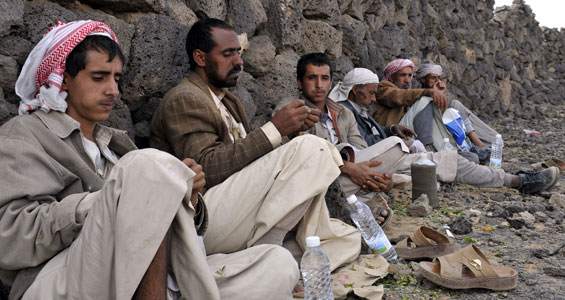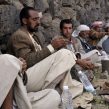
An Assessment of the Anatomy of al-Qaeda in Yemen: Ideological and Social Factors
Publication: Terrorism Monitor Volume: 8 Issue: 9
By:

Yemen has become one of the most important strongholds and safe havens for al-Qaeda. The impact of Yemen’s Salafi-Jihadist movement is no longer limited to that nation and its national security alone. The threat posed by Yemen’s militant Salafists has spread to neighboring countries such as Saudi Arabia and more distantly to the United States, as indicated by the failed Christmas Day suicide bombing of a Northwest Airways passenger plane by Nigerian Umar al-Faruq Abd al-Mutalib, who received his training in Yemen.
Al-Qaeda in Yemen, or al-Qaeda in the Arabian Peninsula (AQAP), as it calls itself at the moment, has gone through different phases. During the era of the Afghan Jihad, Arab fighters recruited a large number of Yemenis, and Osama bin Laden relied on them as personal bodyguards. [1] After the U.S. invasion of Afghanistan in late 2001, they returned to Yemen and Saudi Arabia, focusing their operations on the latter. In February 2006, Yemen’s “Great Escape” of over a dozen leading al-Qaeda suspects paved the way for a process of reorganization of a movement in Yemen and coincided with their withdrawal from Saudi Arabia after three years of armed confrontations with the authorities (see Terrorism Focus, February 7, 2006). Thus, Yemen became a destination for Saudi jihadis and AQAP was born as a coalition of Saudi and Yemeni jihadis (al-Jazeera.net, January 18).
Given the pivotal role that Yemen’s militant Islamists are playing as a host for al-Qaeda and a magnet for jihadis from abroad, this article seeks to analyze the structure of al-Qaeda in the Arabian Peninsula and identify the social and ideological structures that led to its success. In order to obtain reasonably accurate results, the author has collected the names of about 75 people associated with al-Qaeda in Yemen as published, and analyzed them in order to help understand the structure of the organization.
Organization of AQAP
It appears that AQAP draws on three main groups for its recruits: Yemenis, Saudis, and foreigners. [2] According to the author’s analysis, Yemenis form the majority with 56%, followed by Saudis at 37% and foreigners, 7%. This is a key indicator of the level of success that al-Qaeda and Salafi-Jihadists have had in disseminating their ideology among local Yemenis. It also raises the question, in what areas of Yemen in particular have al-Qaeda and the Salafi-Jihadists been most successful.
Upon analyzing the tribal and regional origins of the persons under study, the author found that Yemeni recruits were equally distributed between northern and southern tribes (52% and 48% respectively). The reason for this relatively equal distribution is that al-Qaeda’s discourse finds a ready audience among tribal people, whether in the south or the north. Yemeni journalist Nabil al-Sufi argues that al-Qaeda’s area of influence in Yemen forms a large triangle that is half the size of the country (al-Hayat, January 31, 2009). The triangle starts from Abyan in the west and extends to al-Jawf in the south, passing through large areas of Shabwa governorate as far as Hadramut. From the north, it is connected to the capital city of San’a by Arhab directorate, overlooking the Maqfar triangle that connects it to another three provinces: San’a, Ghamran and Sa’da. The result is the formation of an area known for its tribal affiliations rather than its affiliation to the state and an area where there are few state institutions and where tribal laws dominate.
A focus on tribes in Yemen has been a main reason behind al-Qaeda’s success in finding a safe haven there. Abu Musab al-Suri, the first to see Yemen’s potential as a safe haven for the jihadist movement, has said that the main reason for considering Yemen a stronghold for jihadis is the tribal nature of its people and the solidarity between tribes. [3]. It was for similar reasons that Osama bin Laden addressed the southern tribes of Saudi Arabia in 2004, specifically in Asir province (which borders Yemen), naming the tribes and encouraging them to fight in Iraq. "Oh heroes of Asir and champions of Hashed, Madhaj, and Bakeel, do not stop your supplies to assist your brothers in the land of Mesopotamia [i.e. Iraq]. The war there is still raging and its fire spreading.” [4]
Abdul-Ilah al-Sha’e, a Yemeni journalist, confirms that al-Qaeda has succeeded in building an alliance with the tribal system in Yemen because the country has not been “tamed” or “civilized” like other countries. Tribes are still in control and thus it was easy to build alliances with them. [5] Abdul-Illah said that al-Qaeda wanted to recruit young people who were not afraid of death and found these young people in Yemen’s tribal and Bedouin societies, where acts of revenge and battles between tribes are still dominant, given the absence of state institutions (al-Jazeera.net, January 21).
Conditions of Militancy in the South
Southern Yemenis, who form the majority of the population, were the first to join the Salafi-Jihadi movement. Political conditions in the south have made tribes closer to al-Qaeda. Saeed al-Jahmi, author of an Arabic language text on al-Qaeda in Yemen, has said that the number of al-Qaeda members in the southern part of Yemen is higher than that in the north and gives the following reasons for this phenomenon: the political conditions in the south; the repressiveness of the former Marxist regime; and the political use of violence ingrained in the south during that period. Moreover, the Salafis of the south are different from those of the north, busying themselves with generalities while northerners focused on details. A key element in the development of southern militancy was migration to Saudi Arabia, where many joined Islamic Shari’a schools and first became introduced to the Salafist ideology. Many Yemeni emigrants wanted to return to their home country and seek revenge on those who had deprived them from living in their homeland. In addition, the charismatic personality of Bin Laden (perceived as a hero and savior by some) and the failure of the Muslim Brotherhood to attract southern Salafists to their movement made it easy for al-Qaeda to recruit fighters from the south. [6]
Political conditions in the south and predominant feelings of unequal treatment by the central government made people there vulnerable to al-Qaeda’s rhetoric and ideology. This becomes clear when one reads the letter of Abu Basir al-Wuhayshi, the leader of al-Qaeda in Yemen, entitled “To Our People in the South” (May 13, 2009):
"The events, [suppression of protests by Yemeni security forces] in Lahaj, al-Dale, Abyan, Hadramut and other areas, and the injustice and suppression of people who have no weapons to defend themselves, have gone beyond all acceptable limits. It is our duty to support these people, assist them and lend them a helping hand. Oh free men, resistors of injustice and oppression in Yemen and in the Arab Peninsula, what you are preaching is a right that God and your religion have urged you to preach. It is because you by your nature do not accept injustice and humiliation. With your faith, you were able to resist the British occupation [of the Aden Protectorate, 1839-1967] and to force the [British] troops to leave your country. Then you have practiced your right to peaceful protests. Now even this right, given by the oppressor, is taken away from you. When you protested, you were badly oppressed although your cause was just. If you demand justice, it does not mean that you want separation. [7]"
With regard to Saudi operatives in AQAP, most came from the south of Saudi Arabia (up to 50%), while 39% came from the central area (mainly from al-Qassim) and 11% from other areas (al-Ghad, January 6, 2005). Al-Qaeda members coming from al-Qassim are tribal and conservative in nature. This geographical distribution reflects the huge impact of al-Qaeda’s defeat in Saudi Arabia after confrontations with Saudi troops and the movement’s departure for Yemen.
Al-Qaeda’s focus on recruitment from the south of Saudi Arabia led to an increase in the number of Saudi al-Qaeda members who have tribal connections to Yemeni tribes. The emphasis on tribal unity can becomes clear in a 2004 letter by militant Saudi Salafist ideologue Fares Shuwail al-Zahrani (a.k.a. Abu Jandal al-Azadi), also entitled "To the People of the South":
"I hereby say to the people of the south, the south of the Arabian Peninsula, avoiding all colonial division of our countries, from the Yamani side to the Arabian Sea, to our proud tribes, who God has favored with Islam and made them occupy the world, I say to them that I am proud of being one of them … I tell them that our country is in the middle of the world, we have the Qiblah, Mecca and Medina. We have the richest seas, the most important straits and the greatest reserves of oil. Do you accept that the crusaders and their agents control you? Do you accept that they steal your money and your resources? Would you allow them to kill your sons and daughters? Oh people of the Arabian Peninsula, oh people of the Arabian Peninsula, you are the strategic depth of your fellow jihadists. [8]"
Among the al-Qaeda members recruited from southern Saudi Arabia were seven of the fifteen Saudi 9/11 bombers. Bin Laden highlighted this fact in a recorded speech, saying, “Asir’s tribes formed the lion’s share [of the 9/11 perpetrators], [including] those from Ghamed, Zahran and Bani Shahr [all Asir tribes]. [9]
Conclusion
Based on the above, it is evident that al-Qaeda is attempting to build tribal alliances in the area extending from the south of Saudi Arabia to the south of Yemen. These alliances are made possible by the conservative nature of the Salafi-Jihadi movement’s ideology. If we examine the structure of al-Qaeda, it is clear that the Salafi-Jihadis are succeeding in mobilizing youth in both Saudi Arabia and Yemen, even when their families have good relations with the authorities. It seems that al-Qaeda’s ideology is becoming more influential and is benefiting from injustices in the south of Yemen.
Local alliances have helped al-Qaeda find a safe haven at the strategic level. This has given the movement the capability of carrying out attacks, not only inside Yemen but also outside the country. Examples of this new reach include the attempt to assassinate Saudi Deputy Minister of the Interior Prince Muhammad bin Nayef and the attempt to bomb the Northwest Airlines plane heading from Amsterdam to Detroit. It is clear that traditional tribal relations, injustice, and local grievances are the best allies of al-Qaeda in the Arabian Peninsula.
Notes:
1. Abdel Bari Atwan, The Secret History of al-Qaeda, al-Saqi Books, 2006, p.59.
2. In a February 18 phone interview with the author, Yemeni journalist Abdul-Ilah al-Sha’e, the only journalist to interview Abu Basir al-Wuhayshi, al-Qaeda’s leader in Yemen, said that on his visit to an al-Qaeda stronghold for the interview, he had seen foreign operatives with al-Qaeda, but did not speak with any of them.
3. Abu Musab al-Suri, “The Responsibility of the People of Yemen Regarding the Sanctuary of Muslims,” https://www.tawhed.ws/r?i=wksgfnyz.
4. His letter entitled "Oh People of Iraq", 7 May 2004. The full text can be read on Abu Mohammad al-Maqdisi’s website: https://www.tawhed.ws/r?i=riact8vq.
5. Phone interview with Abdul-Ilah al-Sha’e, February 18.
6. Saeed al-Jahmi, Tanthim al-Qa’ida: al-nasha’at, al-khalfyat al-adyolojya, al-imtidat (al-Yaman nomouthdjan (Al-Qaeda: Its Emergence and its Ideological Background (Yemen as an example)), Madbouli Bookshop, Cairo, 2008, p. 303, pp 306-318.
7. The audio can be downloaded from: https://www.as-ansar.com/vb/showthread.php?p=9394.
8. Fares Shuwail al-Zahrani letter entitled, “To Our People in the South,” May 2004. The audio can be downloaded from: https://www.ukht-benladn.net/mhadrat_show-446.html
9. Osama bin Laden videotape, September 9, 2002, The full text can be accessed at https://www.alqimmah.net/showthread.php?t=9873.





